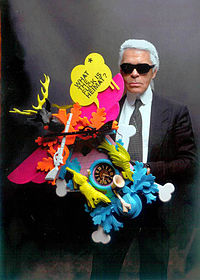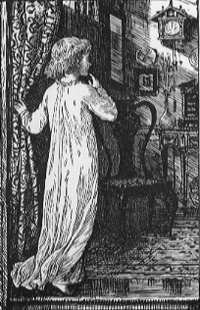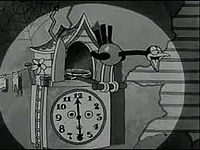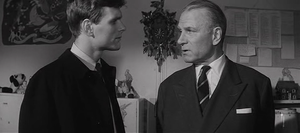- Cuckoo clock in culture
-
 Karl Lagerfeld holding a creation by Stefan Strumbel.
Karl Lagerfeld holding a creation by Stefan Strumbel.
The cuckoo clock, more than any other kind of timepiece, has often featured in literature, music, cinema, television, etc., in the Western culture, as a metaphor or allegory of innocence, childhood, old age, past, fun, mental disorder, etc. It has apparently been viewed more as a symbol or a toy -a folksy musical apparatus with animated figures- fascinating and a bit mysterious rather than as a serious timekeeper.[1]
Although the cuckoo clock functions as a symbol of Switzerland and Swissness, in fact it only has a slim connection with that country in terms of production. Its real home is the Black Forest of Germany.
Contents
Science and technology
Inside Sierra Diablo mountains (Texas), is being built the monumental 10.000 Year Clock based upon an idea of Daniel Hillis who in 1995[2] expressed as follows: "I want to build a clock that ticks once a year. The century hand advances once every 100 years, and the cuckoo comes out on the millennium. I want the cuckoo to come out every millennium for the next 10,000 years."[3] Funded by Jeff Bezos,[4] it is designed to run for ten millennia with minimal maintenance and interruption.[5]
The Discovey Channel TV series Big!, consisted of a team of craftspeople, in welding and metal construction, manufacturing the world's biggest items scaled up to proportions for the sake of setting world records, the devices had to function to qualify. One of the enlarged objects was a cuckoo clock in the episode number 9, although the Guinness World Record was not finally achieved.
Literature
Since its popularization, from the mid-1850s on, it has been a common character in children's literature, comics and cartoons, for educational, comical and/or entertainment purposes. All this is due to children are usually enchanted by the “magic” of a happy bird which lives in a house-shaped clock and pops out to announce the hours. In literature for children examples include:
- "The Cuckoo Clock", by Mrs. Molesworth and first published in Edinburgh (Scotland, U. K.) in 1877, which is the best-known and one of her most celebrated novels for children.[6]
- "The Story of a Cuckoo Clock" (1887), by Robina F. Hardy.
- "The Cuckoo in the Clock", a story by Enid Blyton, first published in the book "Round the Clock Stories" in 1945.[7]
- "The Mouse and the Cuckoo in the Clock" (1947), by William Glynne-Jonnes and illustrated by Will Nickless.
- "Curly Cobbler and the Cuckoo Clock" (1950), written and illustrated by Margaret Tempest.
- "The Happy Hollisters", a book series by Andrew E. Svenson whose number twenty-four is "The Happy Hollisters and the Cuckoo Clock Mystery" (1956).
- "Barnaby's Cuckoo Clock" (Tales of Hopping Wood) (published in 1958), text and illustrations by Rene Cloke.
- "The Late Cuckoo" (1962), text and art by Louis Slobodkin.
- "Hildy and the Cuckoo Clock" (1966), by Ruth Christoffer Carlsen, illustrations by Wallace Tripp.
- "Peter Nick-Nock and the Cuckoo Clock" (1971), authored by Dorothy Edwards, illustrations by Alexy Pendle.
- "Cuckoo Clock Island" (1974), author; Frances Eagar, art by Ann Strugnell.
- "The Cuckoo Clock Castle of Shir" (1980), authored and illustrated by Michoel Muchnik.
- "The Cuckoo Clock" (1986), by Mary Stolz and Pamela Johnson (illustrator).
- "Cuckoo Clock" (1986), by the writer Kavery Bhatt, art by Subir Roy.
- "Cuckoo - Clock Cuckoo" (1988), by the german illustrator and writer Annegert Fuchshuber.
- "Sam Pig and the Cuckoo Clock" (published in 1988), written by Alison Uttley and illustrated by Graham Percy.
- "The Cuckoo Clock of Doom" (1995), part of the Goosebumps series by R.L. Stine
Regarding novels for adults, there are "The Cuckoo Clock" (1946) by Milton K. Ozaki, or "The Cuckoo Clock Scam" (2009) the book nº 14 in the Detective Inspector Angel Mystery series, a character created by Roger Silverwood.
Poetry
In poetry can be quoted both two poems and two poetry books with the title “The Cuckoo Clock", which were authored, the first one by the major English poet William Wordsworth[8] between 1836 - 1842, first published in "Poems chiefly of Early and Late Years" (1842),[9] the second one by the American writer and publisher John C. Farrar, contained in his booklet "Songs for Parents"[10] published in 1921 and finally the poem books by the Scottish poet and writer Andrew Young (1922) and the Irish Shane Leslie's "The Cuckoo Clock and Other Poems" published in 1987.
There are two poems which share the same name too, it is "My Cuckoo Clock", composed by William John Chamberlayne,[11] included in the book of poems "The Enchanted Land" in 1892 and the other one by Robert W. Service,[12] published in the book "Carols of an Old Codger" (1954).
Music
When it comes to the art of music, there is a musical work of the Spanish composer, conductor and violinist Tomás Bretón entitled "El reloj de cuco" (The Cuckoo Clock) (1898), a one-act Comedy Zarzuela divided into three scenes prose, libretto by Manuel de Labra and Enrique Ayuso. Other classical music pieces are;
- "The Cuckoo Clock" (1920), by Leopold Godowsky, the composition number twenty-six from his thirty pieces suite for piano called “Triakontameron".
- "The Cuckoo Clock" (1932), a song for piano and vocal by Thomas Griselle and Victor Young. It was recorded in 1934, performed by the soprano Rosa Ponselle and conducted by Andre Kostelanetz.
- "Cuckoo clock", the best known composition of Lloyd del Castillo recorded in 1939 by Arthur Fiedler and the Boston Promenade Orchestra.[13]
- "The Cuckoo in the Clock" (published in 1957), a piano solo piece by William Scher.
And the compositions used for piano and string students (or for family entertainment) such as:
- "The Old Cuckoo Clock", by Nina Batschinskaja, for piano solo.
- "Cuckoo Clock Piano Duet", by Stuart Young.
- "The Cuckoo Clock", by John Thompson. Published in "The First Grade Book" (1936).
- "The Cuckoo Clock" (2003), composed by Lauren Bernofsky for elementary string orchestra.
- "The Cuckoo Clock Duet" (2005), by Andy Beck, for 2-part voices and piano.
- "Cuckoo Clock" (2006), by Deborah Ellis Suarez, piano solo.
In popular music, serve as examples the Christmas carol "The Cuckoo Clock"[14] by James Hipkins and contained in the weekly British music journal "The Musical World"[15] in 1856, the song "The Cuckoo Clock" (published in April 1909 in “The Ladies' Home Journal),[16] music by Louis R. Dressler and words by William Henry Gardner, the ballad "The Cuckoo Clock" (1916) chanted by Lucy Gates (soprano),[17] and "Cuckoo in the clock" (words by Johnny Mercer and music by Walter Donaldson) recorded by the Glenn Miller orchestra and vocals by Marion Hutton, which became a popular 1939 song in the U. S. To say that the hit was also performed by Johnny Mercer, Bobby Troup, Lena Horne, Sully Mason, Steve Jordan, Mildred Bailey and Martha Tilton.[18]
Years later, in 1962, The Beach Boys released their album "Surfin' Safari" including the theme "Cuckoo Clock". Another example in popular music is Fernando Olvera, the vocalist and leader of the Mexican pop-rock band Maná, who composed one of their most popular and emotive songs “El reloj cucú” (The Cuckoo Clock), from their album “Cuando los ángeles lloran” (1995), nominated for a 1996 Grammy Award for Best Latin Pop Performance.
Sculpture
In the art of sculpture one of the foremost origami artists, Robert J. Lang made in 1987 a work called "Black Forest cuckoo clock" (opus 182).[19]
Likewise, exist two pieces titled "Cuckoo Clock", the first one was cast in bronze in 1991 by the Hungarian sculptor Armand Gilanyi [20] and the second one in Styrofoam and acrylic paint by the American artist Bill Davenport (2005). [21]
On the other hand, the German Stefan Strumbel has been producing since 2005 an unconventional reinterpretation of the traditional c. clock, transforming them with the addition of elements of urban and pop art and painting them with spray using florescent and loud colours. [22]
Painting
With regard to this art, it has been depicted in paintings like; "The Fiddler" (1932),[23] an oil on canvas by the Irish painter Leo Whelan, "Old Samovar and Cuckoo Clock" (1997), a cubist watercolor by the Russian Boris Smirnoff and "The Cuckoo Clock" (2007), oil on canvas painted by the American artist Ann Elizabeth Schlegel.
Graphic arts
In the field of graphic arts, in addition to the illustrators already quoted in the Literature section, it is worth to be mentioned a cuckoo clock plate of the British artist Walter Crane for Mrs. Molesworth's book "The Cuckoo Clock", as well as the pictures created by different illustrators for the various editions of the novel, such as; Charles Copeland (1895), Maria L. Kirk (1914), Florence White Williams (1927), C. E. Brock (1931) and E. H. Shepard for the 1954 edition. Also the print by the American painter and illustrator Norman Rockwell "Courting at Midnight" (1919) display this clock.
On the other hand it has been drawn by cartoonists such as Vahan Shirvanian in his gag cartoon "Cat Hunting in a Cuckoo Clock", Edward McLahlan's "Cuckoo Clock Judge", Dan Reynolds in "Clown's Cuckoo Clock", etc.[24]
Animation
As animated cartoon, it is a recurring character in series, shorts and feature films (many made during The Golden Age of American animation) such as:
- Flip the Frog, "The Cuckoo Murder Case" (1930), by Ub Iwerks.
- Silly Symphonies, "The clock store" (1931), by Walt Disney.
- Betty Boop, "Ha! Ha! Ha!" (1934), by Max Fleischer.
- Merrie Melodies; "Little Dutch Plate" (1935), by Friz Freleng, "Cinderella Meets Fella" (1938), animation by Virgil Walter Ross, etc. Cuckoo clocks abound in Warner Bros. cartoons.
- "Charlie Cuckoo" (1939) and Woody Woodpecker's "The Coo Coo Bird" (1947) or "Calling All Cuckoos" (1956), by Walter Lantz.
- "Pinocchio" (1940), Walt Disney.
- Tom and Jerry, "Dog Trouble" (1942), by William Hanna and Joseph Barbera.
- Popeye, "Ration fer the Duration" (1943), character created by Elzie Crisler Segar.
- "The Bored Cuckoo" (1948), by Bill Tytla.
- "The Cuckoo Clock" (1950), by Tex Avery.
- Secret Squirrel, "Cuckoo Clock Cuckoo" (1965), by Hanna-Barbera.
- Pink Panther, "In the Pink of the Night" (1969), by David H. DePatie and Friz Freleng.
- Dastardly and Muttley in Their Flying Machines, "The Cuckoo Patrol" (1969), produced by Hanna-Barbera.
- The Adventures of Tintin (TV series), The Red Sea Sharks Part 1 (1992), characters created by Hergé.
- Rupert (TV series), "Rupert and the Clock Cuckoo" (1994).
- The Tangerine Bear, (2000). Etc.
Based on a composition by the musician Stephen Coates from The Real Tuesday Weld, the animated music video "Bathtime in Clerkenwell" (2003) directed by Alex Budovsky and being about "The Great Revolution of the British Cuckoos taking over London", won the next awards: The Grand Jury Award for the best animated short at Florida Film Festival 2003, The Best of Show Award from ASIFA-East 2003, the 2004 best animated short at Sundance and the 2004 Sundance Online Film Festival Viewers Award in the animation category.
Computer animation
On computer animation is being used with the objective of telling a story, entertaining and/or commercializing a product. Examples inlude:
- "Coucou clock" (2005), by François Cailleau & Audrey Fobis.
- "Jack the Cuckoo" (2005), a 7 episodes series awarded with the Best Viral Marketing campaign (2006),[25] in the area of Internet and Multimedia, in the tenth edition of the Italian awards Mediastars, the authoritative national event dedicated to advertising, corporate design and multi-media communications campaigns.
- "L'engrenage" (2007), several authors.
- "Le Cou Cou" (2009), by Zed Bennett Jr.
- "Mickey's Adventures in Wonderland" (2009), from the TV series Mickey Mouse Clubhouse.
Theatre
In the drama in two acts "Ganksklukka" (The Cuckoo Clock) (1962), by the Icelandic dramatist, writer and poet Agnar Thórdarson, the author presents a powerful play on the dehumanizing effect of modern life.[26]
Cinema
As the seventh art, this timepiece has figured in different movies throughout the history of cinema, and not by chance, but used as an allegory to tell or indicate us something about the story, characters, reinforce the expressive content of a certain scene, etc. Examples include:
- "The Cuckoo Clock" (1912), a short film with Edward P. Sullivan, Julia Hurley and Charles Herman.
- "The Lodger: A Story of the London Fog" (1927), Alfred Hitchcock.
- "M" (1931), by Fritz Lang. Where it can be seen a cuckoo and quail clock.
- "Doctor X" (1932), by Michael Curtiz.
- Laurel and Hardy's short "Dirty Work" (1933), by Lloyd French.
- "L'Orologio a cucù" (The Cuckoo Clock) (1938), by Camillo Mastrocinque.
- "The Third Man" (1949), directed by Carol Reed, in which Harry Lime (played by Orson Welles) said: "You know what the fellow said—in Italy for thirty years under the Borgias, they had warfare, terror, murder and bloodshed, but they produced Michelangelo, Leonardo da Vinci and the Renaissance. In Switzerland, they had brotherly love, they had five hundred years of democracy and peace—and what did that produce? The cuckoo clock." This remark was not in the script by Graham Greene but was added by Welles (in the published script, it is in a footnote); Greene wrote in a letter (Oct. 13, 1977) "What happened was that during the shooting of The Third Man it was found necessary for the timing to insert another sentence." Welles apparently said the lines came from "an old Hungarian play"; the painter Whistler, in a lecture on art from 1885 (published in Mr Whistler's 'Ten O'Clock' 1888), had said, "The Swiss in their mountains ... What more worthy people! ... yet, the perverse and scornful [goddess, Art] will none of it, and the sons of patriots are left with the clock that turns the mill, and the sudden cuckoo, with difficulty restrained in its box! For this was Tell a hero! For this did Gessler die!" In This is Orson Welles (1993), Welles is quoted as saying "When the picture came out, the Swiss very nicely pointed out to me that they've never made any cuckoo clocks."[27]
- "Invasion of the Body Snatchers" (1956), a science fiction film directed by Don Siegel.
- "Lampa" (The Lamp) (1959), a short film by Roman Polanski and one of his earliest works.
- "Bunny Lake Is Missing" (1965), by Otto Preminger.
- "Blade Runner" (1982), a cult movie directed by Sir Ridley Scott.
- "Out of Africa" (1985), by Sidney Pollack.
- "Saraband" (2003), the last film of Ingmar Bergman. Etc.
Television
 Screenshot from Twin Peaks, showing Sheriff Truman (Michael Ontkean) looking with both curiosity and surprise at the clock.
Screenshot from Twin Peaks, showing Sheriff Truman (Michael Ontkean) looking with both curiosity and surprise at the clock.
Regarding to television, it plays a meaningful role in the next episodes of different TV series such as:
- Kraft Television Theatre, "The Cuckoo Clock" (1954).
- Alfred Hitchcock Presents, "Triggers in Leash" (1955) and "The Cuckoo Clock" (1960).
- The Prisoner, "Hammer into Anvil" (1967).
- Hogan's Heroes, "The Antique" (1969).
- Are you being served?, "The Clock" (1974).
- Twin Peaks, "Realization Time" (1990).
- Married with children, "The Wedding Show" (1993).
- Martin, "Auction" (1997).
- My Name is Earl, "Randy's Touchdown" (2005).
It has appeared on several children's shows as well, such as The Banana Splits Show where it was a secondary character, two same name episodes entitled "The Cuckoo Clock", the first one on Jackanory (season 10, episodes from 36 to 40, 1971) based on Mrs. Molesworth's novel and the second one on Ivor the Engine (1975), as well as some episodes of Fraggle Rock, like “The Thirty-Minute Work Week” (1983), Goosebumps "The Cuckoo Clock of Doom" (1995), a Canadian/American horror series for children based on the same name books by R. L. Stine or in JoJo's Circus episode "Time Flies" (2005).
The British comedy Dave Allen at Large has a sketch taking place in the American West, in which an outlaw loads his revolver and heads for a saloon just before noon, against the pleas and begging of his woman not to go through with it. He tells her, "It's high noon and a man's gotta do what a man's gotta do. There ain't no other time I can do it!" He goes into the saloon where there is a cuckoo clock on the wall. At the stroke of twelve, when the door on the cuckoo clock swings open he shoots the bird. He then tells her, "Like I said, there ain't no other time I can do it!"
British comedian Eric Sykes frequently obtained humour from the cuckoo clock in his house in the 1970s sit-com Sykes. Sykes and on -screen Sister Hattie Jaques treated the clock as though it were a pet, and spoke it as though it was alive. The temperamental bird inside was called Peter, who could usually be called upon to 'cuckoo' at the most opportune moment. [28]
Advertising
This timekeeper is featured in several TV commercials such as Volkswagen, Red Bull, TalkTalk, Mentos.
See also
- List of world's largest cuckoo clocks
- Cultural icon
References
- ^ Richard Mühe & Beatrice Techen, Beha Clocks In the Black Forest Manner. In: NAWCC Bulletin, December 2001: p. 739.
- ^ The Clock in the Mountain. The Technium.
- ^ The 10.000 Year Clock official website.
- ^ Dylan Tweney, How to Make a Clock Run for 10.000 Years. Wired.com.
- ^ The Long Now Foundation website.
- ^ Sanjay Sircar. Classic Fantasy Novel as Didactic Victorian Bildunsroman (...). Project Muse.
- ^ Miscellaneous Blyton Story Books. Stella Books.
- ^ The Poetical Works of William Wordsworth (1892), page 203. Google Books.
- ^ The Poetical Works of William Wordsworth (1892), page 331. Google Books.
- ^ John Chipman Farrar. Songs for parents. Internet Archive.
- ^ Leslie Retallick. Catalogue of the Art Collections. Torre Abbey (Historic House & Gallery). Lieutenant General W. J. Chamberlayne, page 17.
- ^ Robert Service. My Cuckoo Clock. Robertwservice.
- ^ Cuckoo clock. Grandorchestras.com
- ^ James Hipkins. The Cuckoo Clock (A carol for Christmas). The Musical World, Vol. XXXIV, 26 December 1856, p. 819. Google books.
- ^ Richard Kitson. The Musical World (1836-1891). National Information Services Corporation (USA).
- ^ Louis R. Dressler & William Henry Gardner. The Cuckoo Clock. The Ladies' Home Journal, April 1909, p. 51.
- ^ Lucy Gates. The Cuckoo Clock. Can be listened on Internet Archive
- ^ Ralph Mitchell. Johnny Mercer's Songs on CD. The Johnny Mercer Educational Archives.
- ^ Robert J. Lang website. Black Forest cuckoo clock, opus 182.
- ^ Armand Gilanyi website. Sculpture gallery
- ^ Bill Davenport website. Pictures of my art.
- ^ Stefan Strumbel website. Work.
- ^ Leo Whelan. The Fiddler. Crawfordartgallery.
- ^ Cuckoo Clock cartoons by different cartoonists. Cartoonstock.
- ^ Mediastars X Edizione. See Sezioni, Internet & Multimedia, Internet, then Premi I Classificato Viral Marketing
- ^ Scandinavian literature: The development of the Icelandic drama. Source: Britannica Concise Encyclopedia. On the website see Comment, paragraph 4. Heniford.
- ^ Nigel Rees, Brewer's Famous Quotations, Sterling, 2006, pp. 485-86.
- ^ Sykes
Categories:- Topics in popular culture
- Clocks
- Cultural history
Wikimedia Foundation. 2010.



